-
€

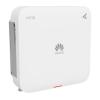
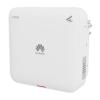

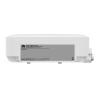
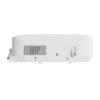
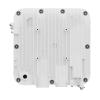
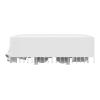
Huawei AP761 è un punto di accesso della serie eKitEngine che supporta lo standard Wi-Fi 6. Supporta i protocolli IEEE b/g/n/ax nella banda 2,4 GHz e IEEE 802.11 a/n/ac/ax nella banda 5 GHz. La velocità teorica massima è rispettivamente di 574 Mb/s a 2,4 GHz e 1201 Mb/s a 5 GHz. Il dispositivo supporta MU-MIMO (trasmissione e ricezione simultanea dei dati da più utenti), BSS Coloring (etichettatura delle trasmissioni per ridurre le interferenze) e TWT (Target Wake Time - funzione che riduce il consumo energetico). Il punto di accesso è dotato di un involucro progettato per l'uso esterno, con grado di protezione IP68, e può essere montato a parete o su un palo. Sono state integrate antenne direzionali con un’ampiezza del fascio principale di 65° orizzontalmente e 40° (2,4 GHz) / 20° (5 GHz) verticalmente, con un guadagno energetico di 10 dBi a 2,4 GHz e 11 dBi a 5 GHz. Le antenne garantiscono un’ottima copertura e permettono di estendere la rete wireless su ampie aree. Il dispositivo dispone di una porta Ethernet Gigabit (10/100/1000 Mb/s) e di uno slot SFP. L'alimentazione può essere fornita solo tramite PoE nello standard 802.3 af/at, con la raccomandazione del produttore di utilizzare lo standard 802.3 at (con 802.3 af alcune funzionalità sono limitate).
Il prodotto offerto può operare in diverse modalità: Fat AP, Fit AP o Cloud. In modalità Fat AP, il dispositivo funziona in modo indipendente e può essere configurato come un normale router wireless. La modalità Cloud consente di collegare il dispositivo a un controller basato su cloud, mentre la modalità Fit AP serve per connetterlo a un controller WLAN AC fisico. Le soluzioni della serie eKitEngine consentono di creare una rete wireless estesa ed efficiente, capace di coprire aree molto vaste. I dispositivi supportano il roaming dati, la gestione della larghezza di banda e diverse modalità di autenticazione. L’AP761 è adatto a molte reti che richiedono copertura all'aperto, come ristoranti, piscine o parchi.
Rete wireless Wi-Fi 6 AX1800, Bluetooth
L’AP761 è progettato per trasmettere una rete wireless Wi-Fi 6, supportando i protocolli IEEE 802.11 b/g/n/ax nella banda 2,4 GHz e IEEE 802.11 a/n/ac/ax nella banda 5 GHz. La velocità teorica massima è rispettivamente di 574 Mb/s a 2,4 GHz e 1201 Mb/s a 5 GHz. Questa velocità è più che sufficiente per la maggior parte delle attività Internet, tra cui lo streaming di film in 4K, il gaming online e il download di file di grandi dimensioni.
Il punto di accesso è dotato di numerose funzionalità avanzate che migliorano la qualità della rete. MU-MIMO consente la trasmissione e la ricezione simultanea dei dati da più client, eliminando i tempi di attesa nella trasmissione. Beamforming ottimizza la direzione del segnale per migliorare la connessione con i dispositivi situati ai margini della copertura, mentre TWT aiuta a risparmiare energia attivando i dispositivi connessi solo quando è necessaria una trasmissione dati.
Inoltre, il dispositivo supporta la trasmissione Bluetooth (BLE 5.2), utilizzabile per la gestione remota, la localizzazione e applicazioni IoT.


Porta Ethernet Gigabit, slot SFP, alimentazione PoE
Il prodotto offerto è dotato di una porta Ethernet Gigabit (10/100/1000 Mb/s) e di uno slot SFP. La porta Ethernet funge anche da ingresso per l'alimentazione PoE nello standard IEEE 802.3 af/at, che rappresenta l'unico metodo di alimentazione disponibile. Il produttore consiglia l'uso dello standard 802.3 at, poiché con 802.3 af alcune funzionalità possono risultare limitate. Il consumo massimo di energia è di 17,7 W.
L’integrazione dello slot SFP consente la trasmissione dei dati tramite cavo in fibra ottica, caratteristica particolarmente utile quando si utilizza AP761 in una posizione remota rispetto ad altri segmenti della rete o in una rete con dispositivi distribuiti.
Antenne direzionali
Il punto di accesso è dotato di antenne direzionali con un guadagno energetico di 10 dBi nella banda 2,4 GHz e un’ampiezza del fascio di 65° orizzontale e 40° verticale, mentre nella banda 5 GHz il guadagno è di 11 dBi con un’ampiezza del fascio di 65° orizzontale e 20° verticale. Grazie a queste antenne, l’AP761 si distingue dalla concorrenza per l’ottima copertura del segnale Wi-Fi, in grado di coprire un’area molto più ampia rispetto ai dispositivi con antenne omnidirezionali. Questo è particolarmente importante in spazi aperti, per i quali il dispositivo è progettato.
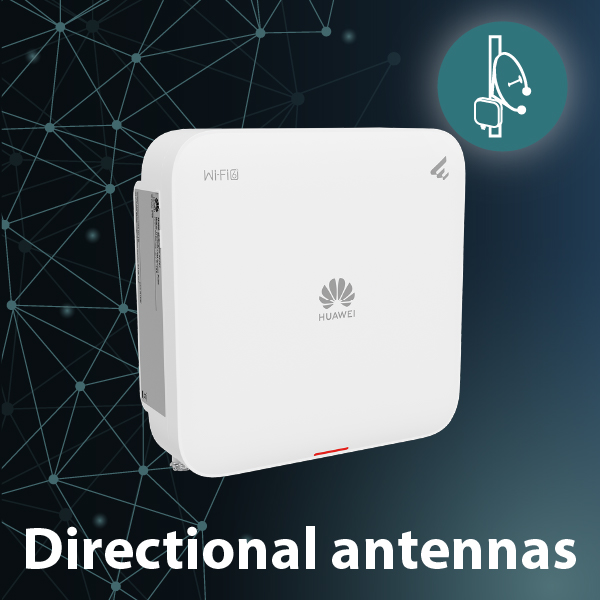

Involucro ermetico
Il dispositivo è completamente progettato per l’uso all’aperto. L’involucro protegge i componenti interni dall’umidità e dalla polvere, con un grado di protezione IP68. Il punto di accesso è progettato per il montaggio a parete o su palo. Un ulteriore vantaggio è la protezione contro le sovratensioni fino a 6 kA, essenziale per l’utilizzo all’esterno.
Fino a 1024 client
Huawei AP761 può gestire fino a 1024 dispositivi client (512 per radio) connessi simultaneamente. È ideale per ambienti con un elevato numero di utenti. Il sistema supporta il bilanciamento del carico e lo smart roaming, trasferendo automaticamente gli utenti su un altro punto di accesso in caso di sovraccarico.
L’algoritmo DFA rileva automaticamente la congestione dei canali wireless e le trasmissioni sovrapposte. Quando vengono utilizzati più punti di accesso, questi operano in modo coordinato per evitare interferenze reciproche. Inoltre, le tecnologie EDCA e airtime scheduling consentono di pianificare l’utilizzo del canale per ciascun dispositivo client, garantendo un accesso equo alla rete.
Un ulteriore vantaggio della serie AP eKitEngine è l’ottimizzazione dell’uso della rete da parte dei dispositivi client. I client con segnale troppo debole o connessione lenta vengono automaticamente disconnessi per migliorare la qualità della trasmissione. L’AP761 è dotato della funzione 5G-prior, che privilegia la connessione alla banda 5 GHz per garantire la massima larghezza di banda possibile, riducendo il carico e le interferenze nella banda 2,4 GHz.


Sistema wireless avanzato
Il prodotto offerto è progettato per operare all'interno di un sistema wireless di grandi dimensioni, composto da più punti di accesso. Una rete così configurata è in grado di coprire ampie superfici, a seconda del numero di dispositivi utilizzati. Il sistema supporta il roaming dati, consentendo agli utenti di spostarsi tra i vari punti di accesso senza perdere la connessione.
Le soluzioni Huawei offrono numerose funzionalità per il controllo della larghezza di banda, il miglioramento della qualità della trasmissione e la sicurezza della rete. Per l'autenticazione degli utenti, puoi utilizzare protocolli come 802.1x, l'indirizzo MAC o il captive portal. Il sistema avanzato di gestione e monitoraggio consente di ridurre il tempo dedicato all'amministrazione della rete, ad esempio rilevando e diagnosticando automaticamente diversi tipi di errori.
Quattro modalità operative
-
Il punto di accesso può funzionare in quattro modalità:
- Fat AP - Il punto di accesso funziona autonomamente e può essere configurato come un normale router wireless. Ideale per piccole reti che necessitano di un solo AP.
- Leader AP - Permette di configurare il dispositivo come "leader", assumendo la funzione di controller di rete. È possibile collegare altri punti di accesso per creare un sistema più ampio. Questa modalità è ideale per piccole reti in uffici o ristoranti e consente di ridurre i costi di acquisto di un controller separato.
- Cloud AP - Permette di gestire il punto di accesso da una piattaforma cloud, semplificando il monitoraggio e la configurazione. Non richiede dispositivi di gestione aggiuntivi.
- Fit AP - Modalità di base che consente al punto di accesso di connettersi a un controller.


Ampie applicazioni
Huawei AP761 trova impiego in numerose reti in cui è necessario distribuire il segnale all'esterno degli edifici. Tra le applicazioni più comuni vi sono hotel, ristoranti, piscine e parchi. Grazie alle antenne direzionali, garantisce un'eccellente copertura e può estendere il segnale su un'ampia area.
L'involucro robusto ed ermetico rende l'AP761 ideale anche per ambienti interni difficili. È perfetto per l'uso in stabilimenti di produzione, magazzini e altri ambienti industriali dove il punto di accesso può essere esposto a polvere e altre condizioni ambientali impegnative.
Specifiche
| Huawei AP761 | |
| Caratteristiche generali | |
|---|---|
| Dimensioni | 69 x 200 x 200 mm |
| Peso | 1,91 kg |
| Interfejsy fizyczne |
1 porta gigabit Ethernet (10/100/1000 Mb/s) 1 slot SFP |
| Bluetooth | BLE 5.2 |
| Diode LED | L'indicatore segnala l'accensione dell'alimentazione, l'avvio del dispositivo, il funzionamento, gli allarmi e gli errori |
| Caratteristiche di alimentazione | |
| Ingresso di alimentazione |
PoE conforme agli standard IEEE 802.3 af/at (Nota: con l'alimentazione 802.3 af, alcune funzionalità saranno limitate) |
| Consumo massimo di energia | 17,7 W |
| Caratteristiche ambientali | |
| Temperatura operativa consentita | Da -40 a 65 °C |
| Temperatura di conservazione consentita | Da -40 a 85 °C |
| Umidità consentita | 0%-100% |
| Grado di protezione | IP68 |
| Caratteristiche radio | |
| Tipo di antenna |
Antenne direzionali integrate Ampiezza del fascio |
| Guadagno energetico dell'antenna |
2,4 GHz: 10 dBi 5 GHz: 11 dBi BLE: 5 dBi |
| Numero massimo di SSID per radio | ≤ 16 |
| Numero massimo di client: | ≤ 1024 (512/radio) |
|
Potenza massima di trasmissione |
2,4 GHz: 28 dBm 5 GHz: 27 dBm |
| Regolazione della potenza | Precisione fino a 1 dBm |
| Numero massimo di canali non sovrapposti |
2.4 GHz (2.412 GHz - 2.472 GHz) 802.11 b/g
802.11 n
802.11 ax
5 GHz (5.18 GHz - 5.825 GHz) 802.11 a
802.11 n
802.11 ac
802.11 ax
|
| Modalita' Fat/Fit AP | |
| Caratteristiche WLAN | Standard IEEE 802.11 b/g/n/ax (2,4 GHz) / IEEE 802.11 a/n/ac/ax (5 GHz) MRC (Maximum Ratio Combining) STBC (Space Time Block Code) CDD (Cyclic Delay Diversity) / CSD (Cyclic Shift Diversity) Beamforming (ottimizzazione del segnale) MU-MIMO (Multi-user multiple-input multiple-output) OFDMA (Orthogonal Frequency Division Multiple Access) Modulazione fino a 1024QAM, supporta anche 256QAM, 64QAM, 16QAM, 8QAM, QPSK e BPSK TWT (Target Wake Time) LDPC (Low-Density Parity-Check) Frame aggregation, inclusi A-MPDU (Tx/Rx) e A-MSDU (Tx/Rx) 802.11 DFS (Dynamic Frequency Selection) GI (Short Guard Interval) in modalità 20, 40, 80 e 160 MHz WMM (Wi-Fi Multimedia) per la gestione delle priorità dei dati Scansione automatica dei canali ed evitamento delle interferenze Nascondi SSID SST (Signal Sustain Technology) U-APSD (Unscheduled Automatic Power Save Delivery) Supporto CAPWAP in modalità Fit AP (Control and Provisioning of Wireless Access Points) ESS in modalità Fit AP (Extended Service Set) ACC (Advanced Cellular Coexistence) per ridurre le interferenze Multi-user CAC (Call Admission Control) Smart roaming 802.11k / 802.11v Fast roaming 802.11r (≤ 50 ms) |
|
Caratteristiche di rete |
Standard IEEE 802.3ab Negoziazione automatica della velocità, auto MDI/MDIX Standard IEEE 802.1q Assegnazione SSID a VLAN VLAN trunk sulle porte Ethernet uplink Canale di gestione su porta uplink in modalità tagged e untagged Client DHCP, acquisizione IP tramite DHCP Supporto tunnel data forwarding e direct data forwarding Isolamento client in una VLAN Controllo accessi IPv4 / IPv6 (ACL) LLDP (Link Layer Discovery Protocol) Supporto CAPWAP in modalità Fit AP Autenticazione unificata del controller in modalità Fit AP Supporto AC dual-link backup in modalità Fit AP NAT in modalità Fat AP IPv6 in modalità Fit AP Telemetria in modalità Fit AP - monitoraggio rapido dello stato dell’AP IPv6 SAVI (Source Address Validation Improvements) Soft GRE (Generic Routing Encapsulation) Protocollo mDNS (Multicast Domain Name Service) |
| Funzioni QoS | Gestione delle priorità e pianificazione secondo WMM Risparmio energetico WMM Mappatura priorità pacchetti upstream, mappatura pacchetti downstream basata sul flusso Pianificazione e gestione della larghezza di banda in base agli utenti e alle condizioni radio Airtime scheduling HQoS scheduling per interfaccia wireless Ottimizzazione per il traffico multimediale |
| Sicurezza | Autenticazione Open System Crittografia / autenticazione WEP con chiavi da 64, 128, 152 o 192 bit WPA2-PSK (WPA2-Personal) WPA2-802.1X (WPA2-Enterprise) WPA3-SAE (WPA3-Personal) WPA3-802.1X (WPA3-Personal) Autenticazione ibrida WPA-WPA2 Autenticazione ibrida WPA2-WPA3 WPA2-PPSK in modalità Fit AP WAPI WIDS (Wireless Intrusion Detection System) e WIPS (Wireless Intrusion Prevention System) Rilevamento di dispositivi rogue e attacchi, blacklist dinamiche Autenticazione 802.1X, MAC, Portal DHCP Snooping DAI (Dynamic ARP Inspection) IPSG (IP Source Guard) 802.11w PMF (Protected Management Frames) Crittografia IPsec / DTLS |
|
Monitoraggio |
Monitoraggio unificato e gestione tramite controller in modalità Fit AP Login automatico e caricamento configurazione (plug&play) in modalità Fit AP Aggiornamenti di gruppo in modalità Fit AP Telnet STelnet con SSHv2 SFTP con SSHv2 Gestione wireless tramite Bluetooth Gestione Web tramite HTTP/HTTPS in modalità Fat AP Monitoraggio in tempo reale e rilevamento rapido degli errori tramite NMS SNMP v1/v2/v3 in modalità Fat AP Allarme di stato del sistema NTP (Network Time Protocol) in modalità Fat AP |
| BYOD | Identificazione dei dispositivi tramite OUI nell’indirizzo MAC Identificazione dei dispositivi basata su UA nei pacchetti HTTP Identificazione dei dispositivi basata sulle opzioni DHCP Il server RADIUS fornisce il reindirizzamento dei pacchetti, la sicurezza e le policy QoS in base al tipo di dispositivo specificato nell'autenticazione RADIUS (solo in modalità Fit AP) |
| Analisi dello spettro | Identificazione di varie fonti di interferenza, inclusi dispositivi Bluetooth, forni a microonde, telefoni cordless, dispositivi ZigBee, controller di gioco, baby monitor elettronici e altri Collaborazione con un server di localizzazione per individuare le fonti di interferenza (solo in modalità Fit AP) |
| Modalita' Cloud | |
| Proprieta' WLAN |
Standard IEEE 802.11 b/g/n/ax (2,4 GHz) / IEEE 802.11 a/n/ac/ax (5 GHz) U-APSD (Unscheduled Automatic Power Save Delivery |
|
Caratteristiche di rete |
Standard IEEE 802.3ab Negoziazione automatica della velocità, auto MDI/MDIX Standard IEEE 802.1q Assegnazione SSID a VLAN Client DHCP, acquisizione IP tramite DHCP Isolamento dei client in una VLAN Lista di controllo accessi (ACL) Autenticazione unificata sulla piattaforma Cloud NAT Telemetria, monitoraggio rapido dello stato dell'AP e dei parametri (solo in modalità Fit AP) |
| Funzioni QoS | Mappatura delle priorità e pianificazione secondo WMM Gestione dei parametri WMM per radio Risparmio energetico WMM Mappatura delle priorità dei pacchetti upstream, mappatura dei pacchetti downstream basata sul flusso Pianificazione e gestione delle code Limitazione della larghezza di banda basata sull'utente Airtime scheduling HQoS scheduling per interfaccia wireless |
|
Sicurezza |
Autenticazione Open System Crittografia / autenticazione WEP con chiavi da 64, 128, 152 o 192 bit WPA2-PSK (WPA2-Personal) WPA2-802.1X (WPA2-Enterprise) WPA3-SAE (WPA3-Personal) WPA3-802.1X (WPA3-Enterprise) Autenticazione ibrida WPA-WPA2 Autenticazione ibrida WPA2-WPA3 WPA2-PPSK in modalità Fit AP Autenticazione 802.1X, MAC, Portal DHCP Snooping DAI (Dynamic ARP Inspection) IPSG (IP Source Guard) |
|
Monitoraggio delle operazioni |
Monitoraggio e gestione unificati tramite la piattaforma Cloud Accesso automatico e caricamento della configurazione (plug&play) Aggiornamenti di gruppo Telnet STelnet con SSHv2 SFTP con SSHv2 Gestione wireless tramite Bluetooth Gestione locale Web tramite HTTP/HTTPS o NMS Monitoraggio in tempo reale, rilevamento rapido degli errori tramite NMS Sistema di allarme di stato NTP (Network Time Protocol) |






 Polski
Polski English
English Italiano
Italiano Español
Español Čeština
Čeština Српски
Српски Deutsch
Deutsch Ελληνικά
Ελληνικά Slovenský
Slovenský




